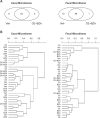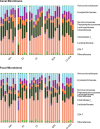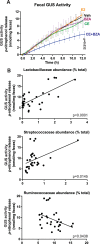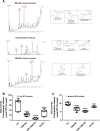Long-Term Administration of Conjugated Estrogen and Bazedoxifene Decreased Murine Fecal β-Glucuronidase Activity Without Impacting Overall Microbiome Community
- PMID: 29802368
- PMCID: PMC5970144
- DOI: 10.1038/s41598-018-26506-1
Long-Term Administration of Conjugated Estrogen and Bazedoxifene Decreased Murine Fecal β-Glucuronidase Activity Without Impacting Overall Microbiome Community
Abstract
Conjugated estrogens (CE) and Bazedoxifene (BZA) combination is used to alleviate menopause-associated symptoms in women. CE+BZA undergo first-pass-metabolism in the liver and deconjugation by gut microbiome via β-glucuronidase (GUS) enzyme inside the distal gut. To date, the impact of long-term exposure to CE+BZA on the gut microbiome or GUS activity has not been examined. Our study using an ovariectomized mouse model showed that CE+BZA administration did not affect the overall cecal or fecal microbiome community except that it decreased the abundance of Akkermansia, which was identified as a fecal biomarker correlated with weight gain. The fecal GUS activity was reduced significantly and was positively correlated with the abundance of Lactobacillaceae in the fecal microbiome. We further confirmed in Escherichia coli K12 and Lactobacillus gasseri ADH that Tamoxifen-, 4-hydroxy-Tamoxifen- and Estradiol-Glucuronides competed for GUS activity. Our study for the first time demonstrated that long-term estrogen supplementation directly modulated gut microbial GUS activity. Our findings implicate that long-term estrogen supplementation impacts composition of gut microbiota and microbial activity, which affects estrogen metabolism in the gut. Thus, it is possible to manipulate such activity to improve the efficacy and safety of long-term administered estrogens for postmenopausal women or breast cancer patients.
Conflict of interest statement
ZME is an investigator on a Pfizer Investigator Initiated Grant.
Figures





References
-
- Wagner JD, et al. Insulin sensitivity and cardiovascular risk factors in ovariectomized monkeys with estradiol alone or combined with nomegestrol acetate. The Journal of clinical endocrinology and metabolism. 1998;83:896–901. - PubMed
Publication types
MeSH terms
Substances
Grants and funding
LinkOut - more resources
Full Text Sources
Other Literature Sources
Medical

